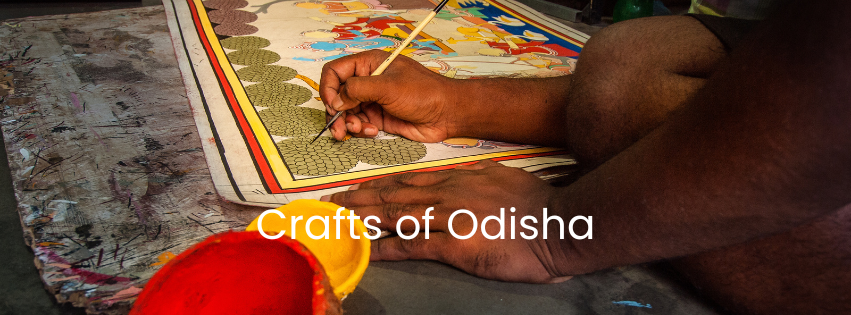One era precedes another era, lives change, cultures evolve, lifestyles transform yet the true glory of a civilization lies in the timelessness of its traditions. In the ever-evolving fabric of time, from ancient indigenous civilizations to the times of the alluring modern ethos, that which has held in itself the essence of its people is the craft of its communities. Embarking on a journey of myth, culture, art, literature, spirituality, and holiness of gods, on the eastern coast of India, dwells the state of Odisha embedded deep in the roots of traditional crafts. The diversity of crafts of Odisha astounds the notion of constant.
The cultural ethos of Odisha echoes the knowledge of its ancestors, who carefully passed the essence of its crafts from one generation to the other. For example, today more than 62 tribes with their unique forms of craft breathe life into the craft glory of Odisha, in the realm of its crafts, its deeper layers unfold weaving together tales of the diverse history of crafts, its evolution, techniques, and materials, and at the very core of its heart, the stories that these craft narrate.
The crafts of Odisha reflect a rich cultural tapestry, contouring right from preserving the ancient narratives, and keeping alive the vibrancy of the past to living in synchrony with the forces of nature. It inculcates the natural elements that drive the spirit of Odisha crafts.
Pattachitra
“Chitra” the word in itself holds a million meanings, a visual image can be as deep as an ocean, while “Patta” the cloth, encapsulates the vast meanings and vivid subjects in the painted fabric. Rooted deep in the history of storytelling, the paintings of Pattachitra embed in their imagination past myths, and stories of gods and goddesses, and staying true to its Odia spirit, the glory of lord Jagannath. Pattachitra’s works hold in them every emotion and every expression, the painted faces speak of human feelings, of devotion, love, joy, anger, and even of those emotions that are not confined in words.
A gaze through the Pattachitra manoeuvres one’s observation in numerous ways, the enchanting floral border sets the stage to traverse inside, in vibrant hues are painted stories, human figures with protruding eyes like a stretched bow ready to release the arrow of expressions, the compositions that are layered like one story unfolding after the other. The core theme comes to life with flora and fauna, predominant motifs, and colours that breathe life into the story.
The colours made naturally follow a process of their own, the Chitrakars, the artists whose hands move swiftly through the Patta, pursue their craftsmanship with utmost faith and purity as if like the characters of the Pattachitra are speaking to them. There are many towns in Odisha where the craft of Pattachitra is practiced of which Raghurajpur is a place where every house is blessed with Chitrakars, where every wall is painted with the presence of the Pattachitra.
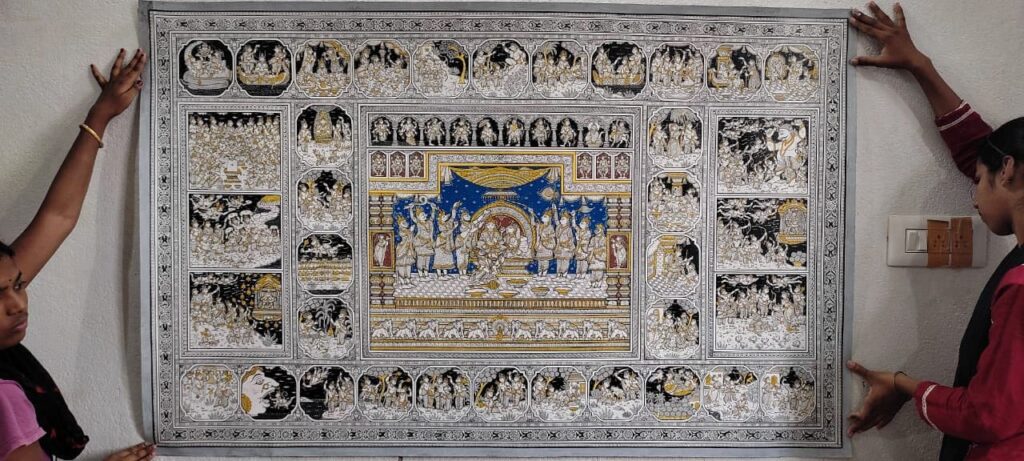
Dhokra Metal Casting
A nostalgic reminiscent of the bronze age takes the form of figures and sculptures through the craft of Dhokra. The long-lost civilization of the Indus Valley finds its traces alive today in the living tradition of this lost wax metal casting. Testimony to the invention of metal techniques the process of Dhokra brings alive glimpses of the famous dancing girl figurine from the Harappan times.
It is astounding to see how a craft survives through the ages, changing rulers, migration, and constant contestations, could not diminish the spirit of Dhokra. The craft of Dhokra incorporates a meticulous method of meteorological knowledge blended with artistic inhibitions. The Dhokra master craftsman, the Shilpi, processes the making of the sculptures through more than 25 steps, which include first building the form with soil mixed with dry grass, beeswax, wax threads, mustard oil, binding substance, the materials vary in different techniques, such as hollow casting, solid casting, mixed casting.
The themes of the Dhokra cast derive its essence from the holy divinity of gods and goddesses, diya lamps for prayers, objects related to temples and prayer rituals, and also a plethora of Indian motifs. Dhokra Craft also has been a pioneer in producing utility items. Altogether narrating the craft has been a dynamic asset and has taken forms and shapes under the need of both the artistic and functional realm. Till today it stands united and has embarked on its journey of building itself as one of the finest crafts of the country.
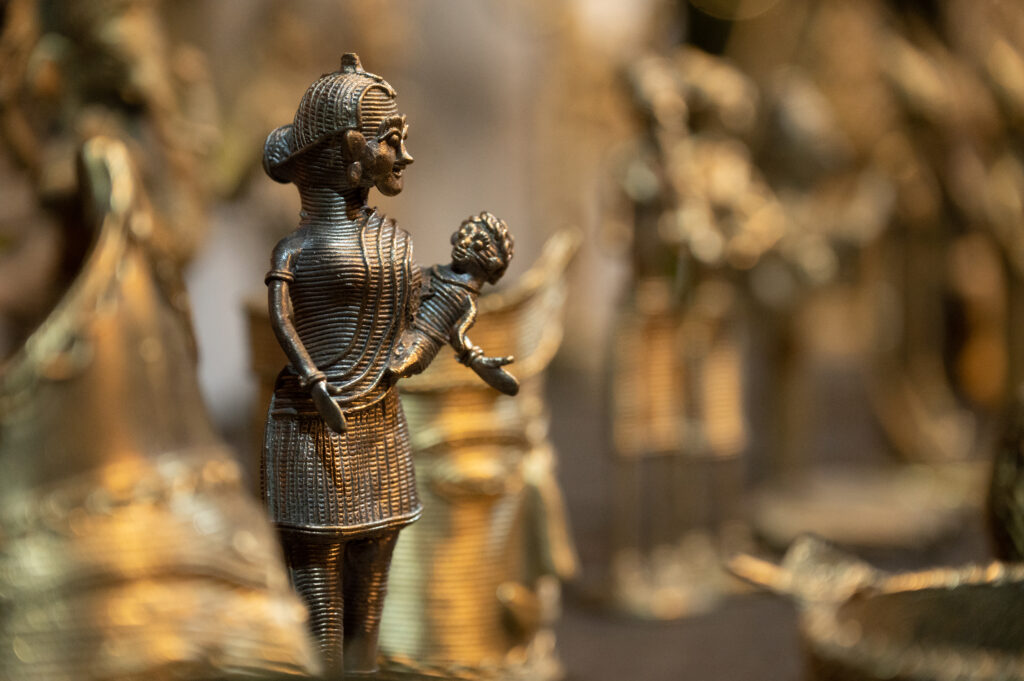
Saura Paintings
Living in synchrony with nature, indigenous tribes have always left their footprints on their dwellings. From the oldest surviving cave paintings, one can see how man has semiotically drawn figures. Saura, being one of the oldest tribes of Odisha encompasses in their paintings, a living connection between man and his ancestors.
It is the spirit of the Saura tribal ethos that is reflected in the intricate lines of Saura paintings, traditionally drawn on mud walls the geometricity of it withholds a ritualistic connection. Saura paintings are made on occasions of new beginnings, during childbirth, while building a new house and the tradition says that for the tribe it is the soul of nature that breathes life through these paintings. The tribals have always sought solace in nature, it is the local gods that save them from calamities, grant boons for a good harvest, and save them from diseases.
The Saura’s conscious spiritual communication with nature is done by carefully covering the walls with mud and rice powder, and pointed bamboo sticks are dipped in natural pigment to create sacred geometry which lays the foundation of their belief in speaking to god through art.
Often similarities are drawn between Saura and Warli art of Maharashtra, which shows a twin linear quality but are unique in their ways, what sets them apart are the very personal beliefs of the tribes and the composition of the story of paintings when finely observed. In the end, the connection with nature is what unites all tribes of India together.
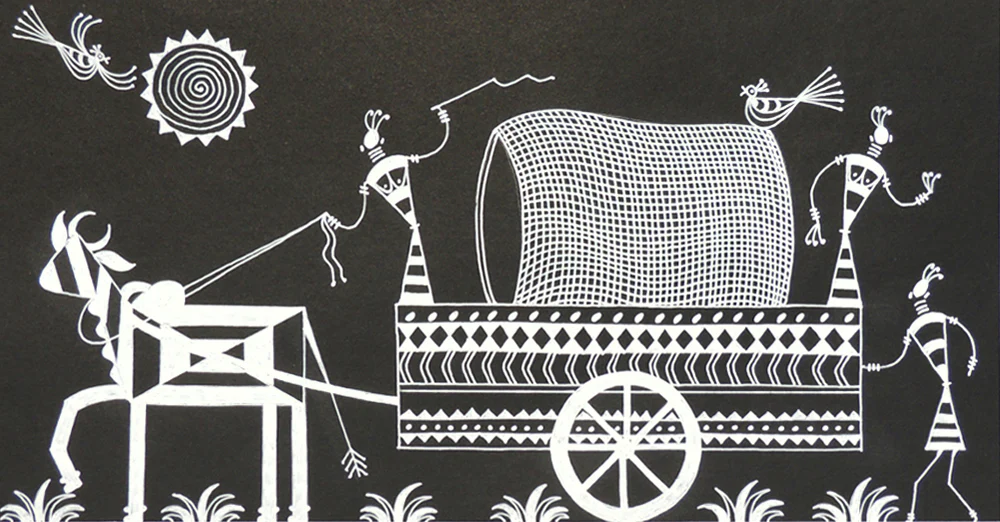

Pipli Applique Textiles
The Rath Yatra of Jagannath Puri is celebrated with an orchestra of textiles, crafted in the Pipli village, where every member of the community plays a significant role in building the divine Chandua – an umbrella-shaped canopy, which is an inseparable part of the lord’s procession. Textiles are considered a testimony to the evolution of civilization and so is the practice of applique work of Pipli, which began as a craft patronized by the king in the 11th century to decorate the Jagannath Yatra, which is flourishing as a prominent craft of Odisha till today.
An avalanche of textiles, the applique work of Pipli undertakes a tremendous amount of precision and labour, it is the laying of one fabric cut piece over the other to form an array of shapes and patterns ranging from birds, animals, floral motifs, and geometrical traditional designs. The patch worked textiles and then further decorating them with mirrors and colourful embroidery. The essence of the craft is relishing the combination of its colourful patchwork, beads and mirrors, threadwork, and most importantly its strength and durability. The culmination brings together the joyful craft of Pipli where men and women both equally participate in it, where the tailor locally known as Darji, stitches the patches together. Darji word comes from Urdu origin and it is said that the craft survived through the Islamic invasions and today both Hindu and Muslim tailors, Darjis, together create the craft of the Lord. In contemporary times, it has adapted to various forms of utility.
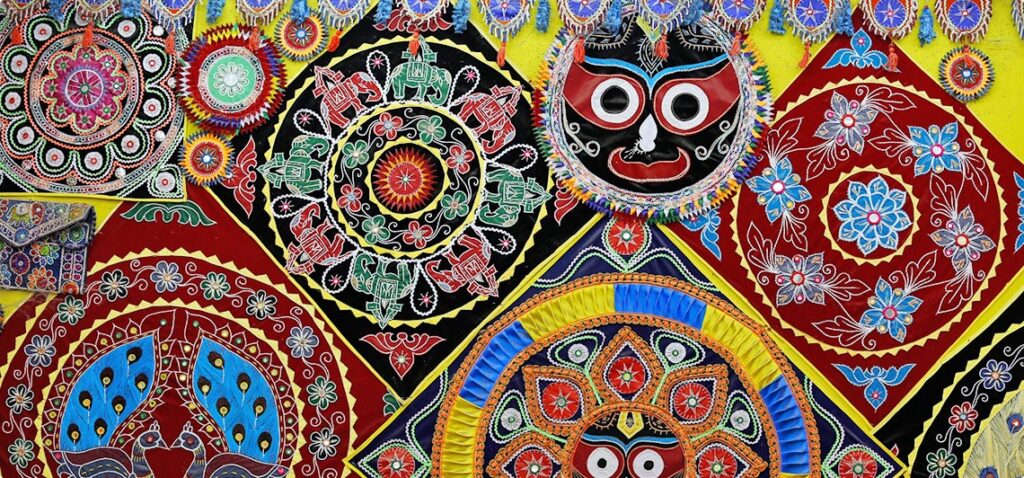
Terracotta – Mruttika of Odisha
ମାଟି ମଧୁର, ମାଟି ପୂଜା, ମାଟି ମୁଖରେ ଜଗନ୍ନାଥଙ୍କ ଛାୟା
Clay is sweet, clay is worship, In clay’s face lies the reflection of Jagannath.
Terracotta crafts are deeply ingrained in the blood of Odisha, they run through the veins of its folk and tribal communities. The earthiness of clay is a symbol of the tribes connected to the soil, their mother nature the earth that embodies the spirit of life.
Indigenous people believe one is born from the soil and one returns in the soil the rest in between is the cycle of life, and hence clay becomes a medium not only of terracotta craft but binds the lives of tribes with nature. The versatile quality of clay is that it takes the form of everything and can be moulded to make items of utility to idols of gods.
Many villages of Odisha are famous for the craft of clay, Barapalli village of Baragarh district, and places such as Nuagaon, Haladharpur, and Kotpad in Koraput district have been since centuries important centers of the terracotta craft of Odisha. A wide range of terracotta vessels are used in the preparation and serving of prasad at the Jagannath temple and are an inseparable part of the temple processions and celebrations. Right from the functional forms of the common man to the idols of god, Odisha’s terracotta stands as the embodiment of the finest craftsmanship.
Which craft of Odisha intrigues you the most? Have you seen the recent injection of contemporary elements in these traditional art forms?
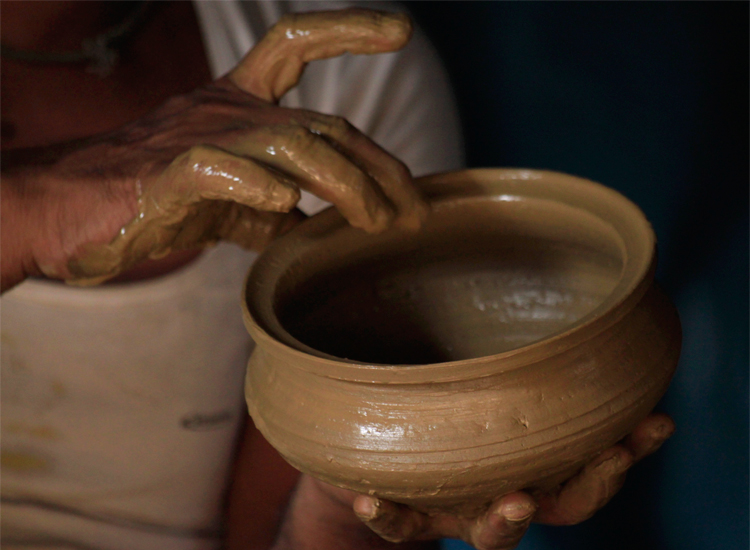
Words by Dhara Mayavat, she is an Architect and Art Historian, graduated from the Faculty of Fine Arts, Baroda. She has been working in the realm of Museums, Archiving, and writing on cultural heritage. Her research and documentation practices are rooted in close observations of the diverse sustainable cultural traditions of South Asia, innately covering subjects of indigenous art.

